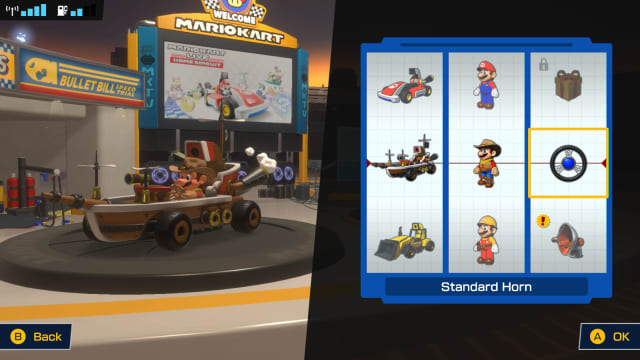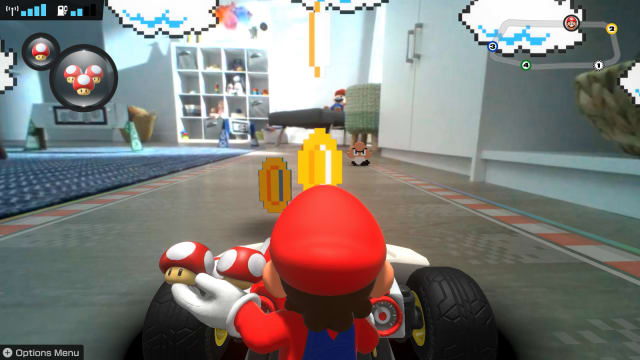
Mario Kart Live: Home Circuit was actually announced last month, but today Nintendo revealed new details about the “mixed reality” game ahead of its launch on October 16th. The software is free to download but it won’t work without one of the camera-equipped toy karts, which cost $99 apiece for Mario or Luigi. So, while there is a single-player mode, you’ll have to shell out double to race against a friend or sibling — and more if they don’t have their own Switch, since each player must have their own device. Up to four karts can race at a time, so if you want to do Mario vs. Mario vs. Mario vs. Mario, knock yourself out. If that’s confusing, then you can customize your outfit and kart by unlocking more options in the game.
The first additional costume and vehicle you unlock are the builder outfit and yellow digger from Super Mario Maker. After that the selection becomes completely random, so you’ll have to keep playing if you have your heart set on dressing up Mario or Luigi like a knight and driving him around in an airship. The in-game kart designs have some cool animations like smoke coming out the tail pipe but, unlike the different vehicles in the main Mario Kart series, there are no effects on speed or handling. Nor will your friends see your cool outfits on their own screens; it’s entirely for your personal enjoyment.

Since the track won’t change unless you choose to redo it, variety is added to the various cup challenges in-game by changing the environment itself. You might end up underwater, or in an 8-bit world. On screen things will look different, while various items and obstacles will have an effect on your physical kart as well. A sandstorm will cause it to slow down, while a banana peel will make you lose control.
 Nintendo
NintendoSince the game uses the gates to draw the course, players really are on the honor system when it comes to following the track — unless you choose to build walls out of cups or boxes in the real world. In fact, Nintendo is encouraging users to take a DIY approach to their tracks, just as it did with the various Labo projects. You can decorate your track and place obstacles to avoid, like plastic balls to block the way or table legs right down the middle. The game won’t recognize them so your virtual opponents won’t be affected, but when you’re racing against friends it can add an extra wrinkle into your racing strategy.
One thing you will definitely need is space. The minimum area needed is a 10 x 12 foot space, which means my dreams of setting this up in my living room have been shattered. However, Nintendo recommends 15 x 15 feet, especially when you’re racing karts at higher velocities. One thing carried over from previous titles are the various racing speeds, even the extra-crazy 200cc. You’ll need more space to turn when you’re going that fast. But the game won’t throw you into the danger zone right away, starting you out at 50cc and letting you unlock the faster settings as you get better at driving.
 Nintendo
NintendoPlayers with carpeting need not worry, as the karts handle just fine on most rugs, though a Nintendo spokesman advises staying away from shag carpeting and tassels. Obviously the kart will move a little slower than it would on a hardwood floor, which puts you at a disadvantage when facing off against the Koopalings, since the game itself won’t acknowledge the difference in texture. It also won’t recognize differences in elevation, so you can’t build a multi-level track. You might be able to get away with a small ramp, but nothing more elaborate. Another thing to keep in mind when building a track is that the cars’ Bluetooth range is limited, so you can’t go bigger than 30 feet and again, Nintendo recommends staying within 15 feet for the best results.
Despite the caveats, Home Circuit looks very promising, as well as a huge step beyond similar products like Hot Wheels’ AI and Augmoto racers. That $99 price tag is a bit of a concern, but the DIY aspect of building the physical track building means it’ll certainly keep your kids busy this fall.




